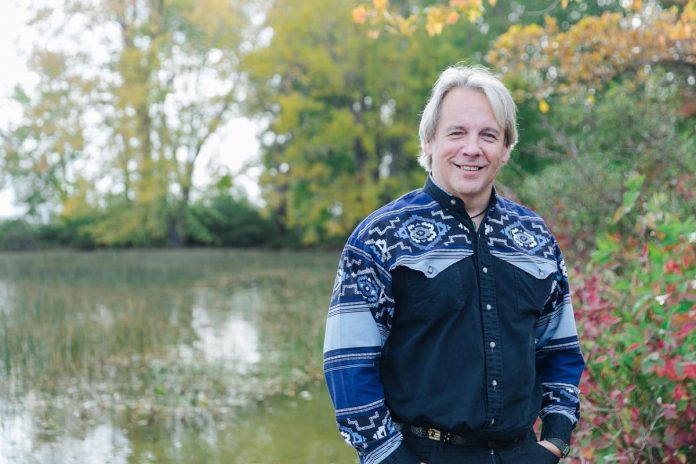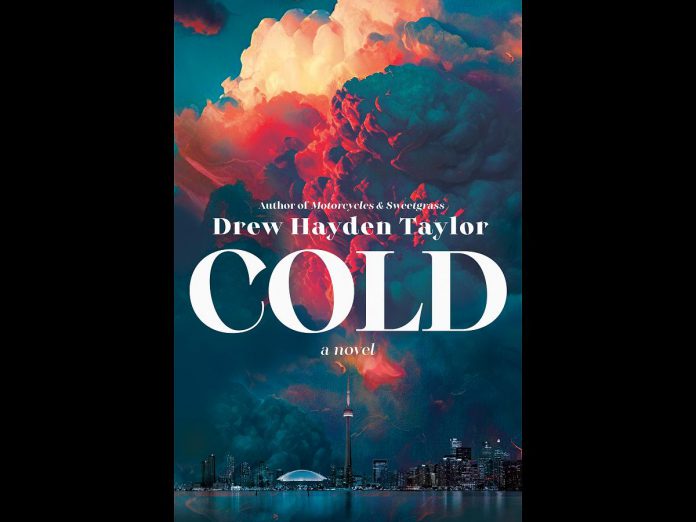
Whether it’s through theatre productions, essays, novels, or documentaries, every story Curve Lake First Nation writer Drew Hayden Taylor tells is one that transcends communities, celebrates Indigenous ways of life, and bridges the gap between cultures.
Taylor’s next release, a novel titled Cold, is no different, as it introduces an Indigenous myth into a contemporary setting. Published by McClelland & Stewart, the 368-page novel is being released by Penguin Random House Canada on January 9, 2024.
Kicking off with a tragic plane crash that leaves its survivors fighting for their lives, Cold follows several characters who seemingly have no connection to one another — until they do. There’s an Indigenous Hockey League player, an alcoholic professor of Indigenous studies who is having an affair with a student teacher, a journalist-turned-author who published a memoir about surviving a plane crash, and a detective investigating a string of gruesome murders in Toronto.
When the characters come together under realization that someone might just be hunting them all, the novel heightens with a deadly battle and unpredictable conclusion.
“I have taken a character from traditional Anishinaabe mythology and modernized it,” says Taylor. “I’ve put it in the middle of the largest city in Canada and I put it on a rampage.”
That mythological character is the Wendigo, a malevolent and cannibalistic spirit rooted in both Anishinaabe and Cree oral tradition.
“It’s a metaphor frequently used for greed,” says Taylor, adding that the basic story follows a creature who will eat anything and everything. “It’s a story about appetites and people who can’t get enough — you might have a certain amount of money, but it’s never enough, or you have a certain amount of power, but you want more. The Wendigo is about desires grown to excess.”

It’s not the first time Taylor has employed Indigenous folklore in his writing. His novel Motorcycles & Sweetgrass, which was shortlisted for the Governor General’s Award in fiction in 2010, featured Nanabush — a mischievous trickster, shapeshifter, and culture hero in the Anishinaabe storytelling tradition.
“I wanted to take another character from Indigenous mythology and put them in a contemporary environment and see what happens,” he says about Cold. “The Wendigo is an interesting character because it’s known as one thing — the Cannibal Spirit — but it is a larger metaphor for many other things and that intrigued me.”
Taylor first began writing his modern take on the Wendigo between 20 to 30 years ago, though originally he penned the story as a screenplay for a feature film.
“As I’ve discovered in my life, sometimes a story isn’t ready to be told then — it needs to marinate, it needs to mature,” Taylor says, adding that his previous works The Night Wanderer and Sweetgrass & Motorcycles were both started long before their publication and were originally written as a play and screenplay respectively. “While the structure of the story may not always work, the story is usually stronger than the box that it’s put into, and sometimes it needs a different box.”
Taylor explains he became inspired to pick up the story again while working as a writer-in-residence at the Berton House in Dawson City, Yukon, in 2017. After hearing a lecture from The Book of Negroes author Lawrence Hill and having dinner with him, Taylor became “so invigorated” that he went home and immediately wrote the first 2,000 words of Cold.
After shelving the work-in-progress for a few years for other projects, Taylor finally found the time to focus on it during the pandemic, and this time the story took a different style than many of his other works.
“I always wanted to write a thriller and I wanted to write a horror novel,” notes Taylor, adding that he also wanted the story to be largely plot-driven in a way many of his other works aren’t. “I wanted to write something that had a very strong narrative in it, where you had to follow this story in order to understand what was going on.”

The writing process proved to be an enjoyable one for Taylor.
“Who doesn’t want to write something that’s scary with the big monster and big fight scene — almost like a Marvel film,” he asks. “As I was writing it, I was just having so much fun.”
Though it takes on an adventurous storyline, readers should know that right from the start, Cold includes the same easy and lighthearted humour that one has come to expect of Taylor. After all, that’s how he makes the story accessible to all, no matter the audience.
“I’m always interested in whacking the Indigenous funny bone,” he says. “I’ve been very fortunate to have travelled to over 150 First Nation communities in Canada and the United States and everywhere I’ve been, I’ve been greeted with a laugh, a smile, and a joke.”
Taylor explored his interest in Indigenous humour in Me Funny, his 2006 edited collection of essays from various writers. Since then, he has always paid close attention to the power of humour and what it means in Indigenous culture.
“Frequently, the dominant culture thinks of native people as thinking only of doom, gloom, anger, problems, et cetera,” he points out. “But we’re very funny people with a marvellously developed sense of humour, so I’m very much into healing through humour.”
Further weaving Indigenous culture, Cold includes title chapters written in Anishinaabemowin.
“I wanted to reinforce for the reader that this story, and the Wendigo, goes back to a long time ago and it was originally told in that language,” Taylor explains.
VIDEO: “Going Bushcraft” Teaser – Going Native Season 2
As Cold nears its release date, Taylor is also in the process of recording the narration for the third season of his APTN documentary Going Native, where he visits communities to explore Indigenous ways of life in the 21st century.
With season one and two journeying through communities across Canada and the United States, for season three, Taylor — who is the show’s host, writer, producer, and director — learns from people across the globe from Mexico to New Zealand, Australia, and the Arctic.
“There’s so many interesting Indigenous peoples around the world so we wanted to start bringing them into the circle and show the wonderful, the wacky, the interesting and the amazing things they’re doing,” he says. “We’re aiming to erase stereotypes and educate the public as to the way native people currently live and enjoy life.”
With both Cold and the third season of Going Native to be released in the coming months, there are three things that Taylor aims to do, which is his goal in all his writing.
“My journey as a writer — whether it’s theatre, articles, essays, or novels — is always to entertain, to educate, and to illuminate.”
Cold will be on bookshelves and available as a paperback, e-book, and audiobook beginning January 9, 2024. For more information on Taylor’s work, visit drewhaydentaylor.com.


























